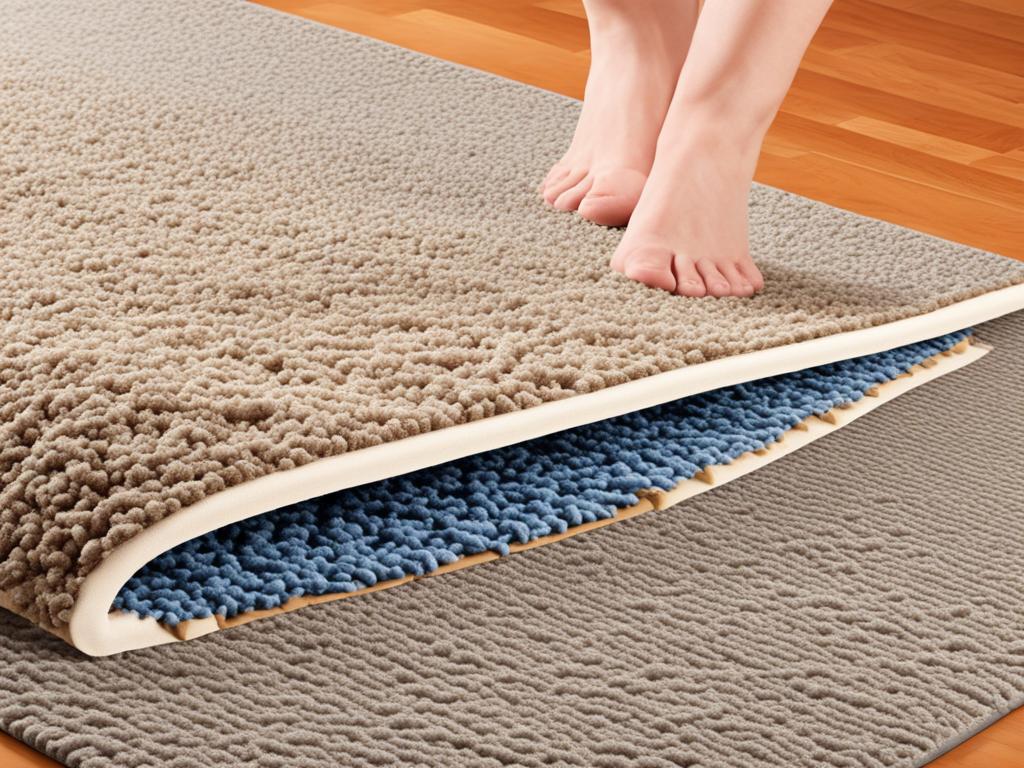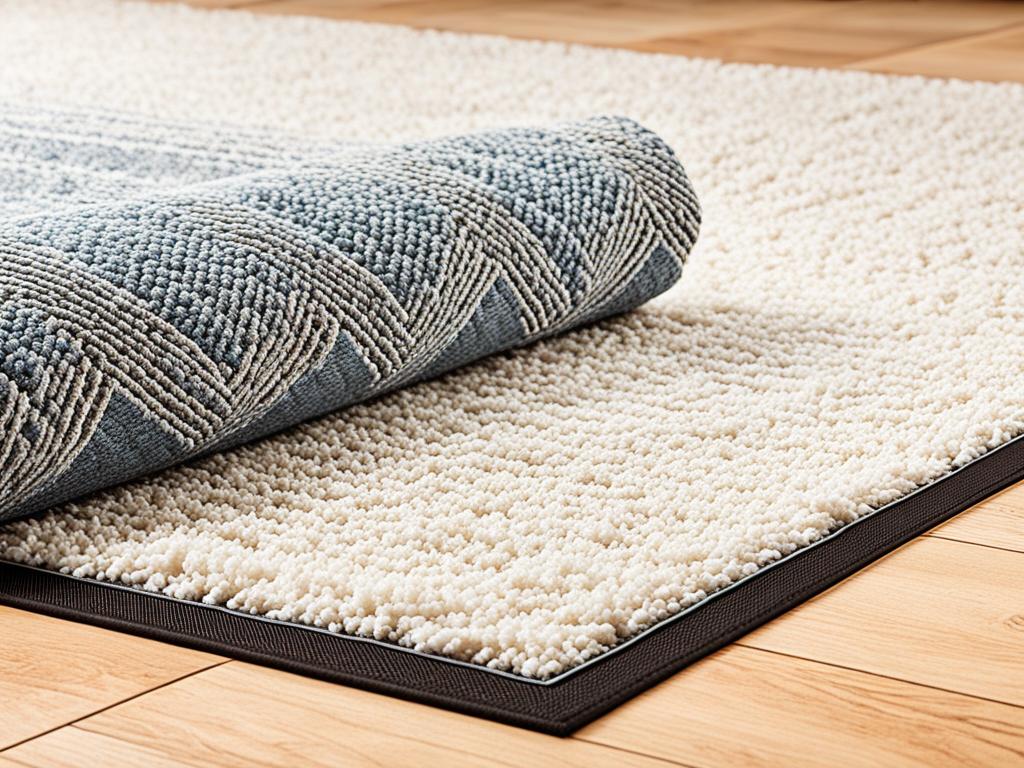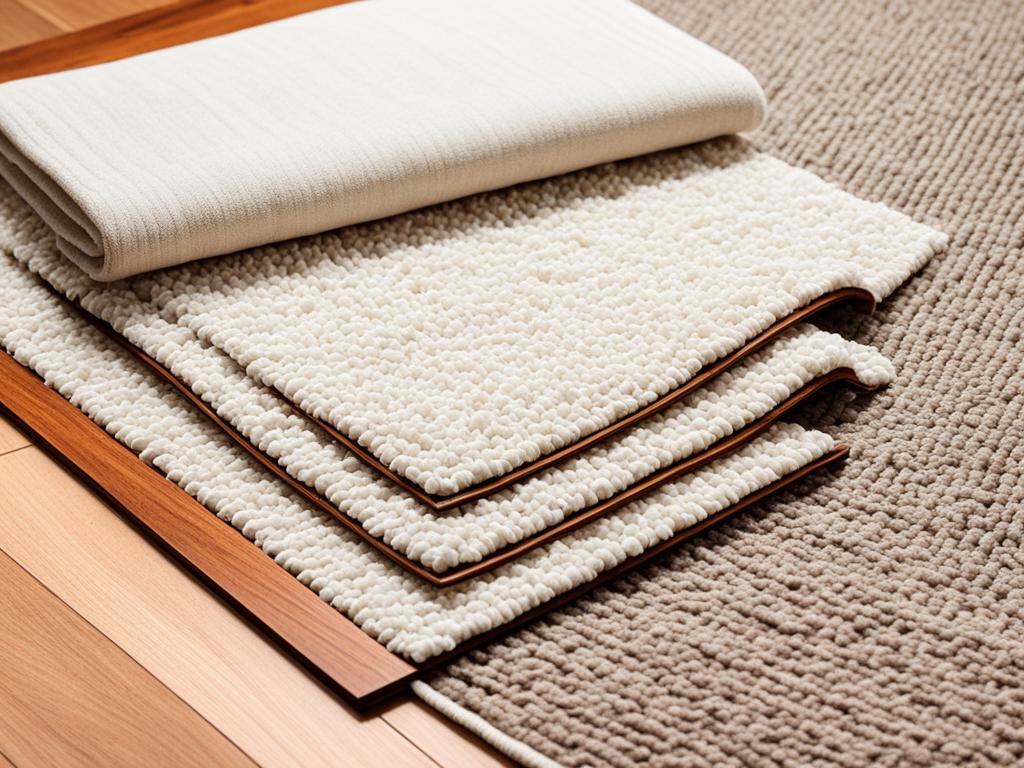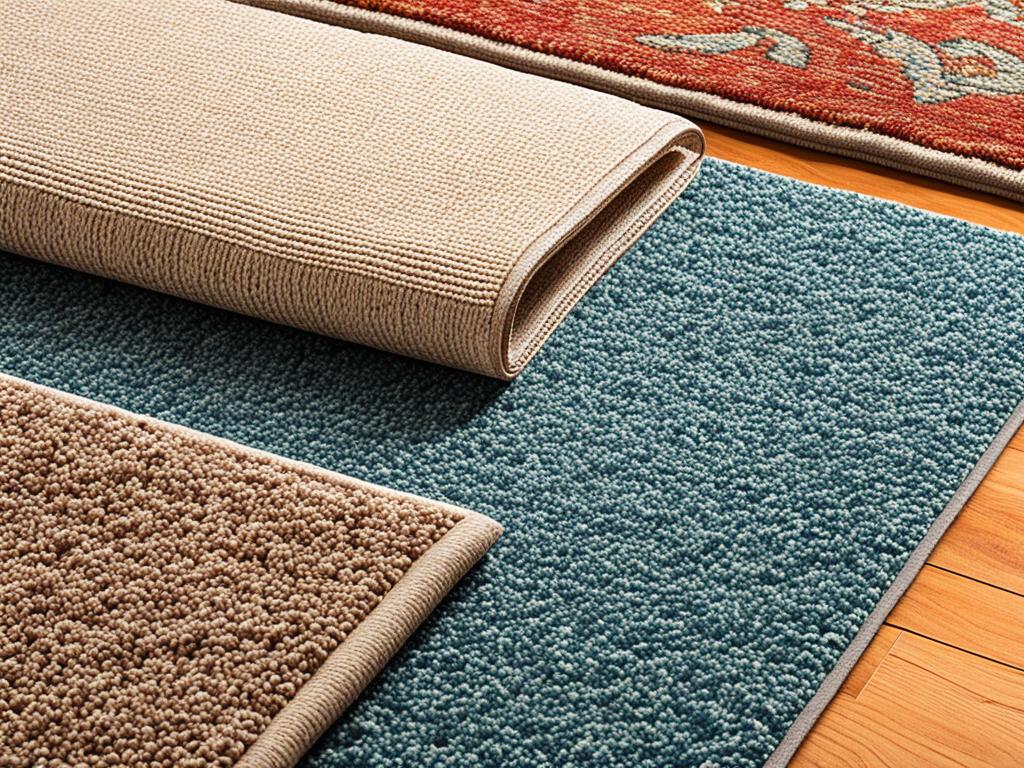Rug pads are an essential component of any well-designed space. They provide comfort, protect your floors, and keep your area rugs securely in place. However, when choosing a rug pad, one important factor to consider is its thickness.
A rug pad’s thickness can greatly impact its performance and functionality. In this comprehensive guide, we will explore the benefits of different rug pad thicknesses and help you choose the ideal thickness for your specific needs. So, if you’ve been wondering, “How thick should my rug pad be?” or “What thickness rug pad should I choose?” we’ve got you covered.
Key Takeaways:
- Choosing the optimal rug pad thickness is crucial for comfort, floor protection, and stability.
- Thick rug pads provide extra cushioning, better floor protection, soundproofing, insulation, and a neat layered look for your rugs.
- Thick rug pads are recommended for heavy furniture, thicker pile rugs, noise reduction, and heated floors.
- Thinner rug pads are suitable for flat weave or smaller rugs and lighter rugs that require grip without excessive bulk.
- The choice of rug pad thickness depends on the size and type of your rug, providing a balance between grip, cushioning, and functionality.
The Benefits of Thick Rug Pads
Thick rug pads offer a range of benefits for both your area rugs and floors. With their dense composition, these rug pads provide extra cushioning, making your rugs even more comfortable to walk or sit on. The additional padding creates a plush feeling underfoot, allowing you to enjoy a luxurious experience in your living spaces.
One of the primary advantages of thick rug pads is their ability to provide better floor protection. The dense construction acts as a barrier between the rug and the floor surface, preventing any slipping or scratches. This feature is particularly beneficial in high-traffic areas where rugs are more susceptible to movement and potential damage.
Another advantage of thick rug pads is their contribution to improved soundproofing in your space. The added density of these pads helps to absorb and reduce ambient noise, creating a quieter environment. Whether you’re looking to create a serene atmosphere in your home or simply minimize noise disturbances, thick rug pads can significantly enhance your overall living experience.

Moreover, thick rug pads offer effective insulation, making them an excellent choice for all seasons. The added thickness helps to regulate temperature by providing insulation against cold floors during the winter and creating a barrier against heat transfer in the summer. This insulation property ensures a comfortable indoor climate while also helping to reduce energy consumption.
Lastly, thick rug pads contribute to a neat and layered look for your rugs. The extra padding prevents the rugs from wrinkling or bunching up, maintaining their smooth and uniform appearance. This layered effect adds depth and dimension to your living spaces, enhancing the overall aesthetic appeal of your interior design.
In summary, the benefits of thick rug pads include extra cushioning, improved floor protection, enhanced soundproofing, effective insulation, and a polished layered look for your rugs. By investing in a thick rug pad, you can elevate the comfort, style, and longevity of your area rugs while also maximizing the performance and enjoyment of your living spaces.
When to Use a Thick Rug Pad
Thick rug pads serve various purposes and are particularly useful in specific situations. Here are some scenarios where using a thick rug pad is beneficial:
- If you have furniture with significant weight:
- For thicker pile rugs:
- To reduce noise:
- For homes with heated floors:
An essential function of a thick rug pad is its ability to absorb the weight of heavy furniture. Placing a thick pad between your rug and the floor helps distribute the furniture’s weight evenly, preventing damage to both the rug and the floor underneath.
Rugs with thicker pile, like Persian or Oriental rugs, benefit from the lift and cushioning provided by a dense rug pad. The extra thickness adds support and enhances the overall comfort and durability of these rugs.
If you’re concerned about noise reduction in your space, a thick rug pad can help. By providing greater density and insulation, it helps absorb sound, minimizing both footfall noise and noise complaints from neighbors.
If you have heated floors or live in a hot climate, a thick rug pad with high thermal resistance is ideal. It acts as a barrier, preventing heat loss during colder months and resisting heat transfer from the heated floor, ensuring optimal comfort indoors.
By considering factors like furniture weight, rug type, noise reduction, and heated floors, you can determine when using a thick rug pad is the right choice for your specific needs.

When Not to Use a Thick Rug Pad
While thick rug pads have their benefits, there are situations where a thinner rug pad is more suitable.
- If you have a flat weave or smaller rug, a rug pad with a natural grip instead of thickness is recommended. This type of pad will prevent slipping and keep your rug in place without adding unnecessary bulk.
- For medium-size rugs in high-traffic areas, a thinner, durable rug pad is a better choice to ensure stability without causing tripping hazards.
- Additionally, if you have lighter rugs that are prone to slipping, a low-profile felt-rubber rug pad can provide adequate grip and protection without excessive thickness.
It’s essential to choose the right rug pad that suits the specific needs of your rugs and floors, taking into account factors such as rug size, weave type, and the level of grip required. Opting for the appropriate rug pad thickness will help maintain the beauty and functionality of your area rugs while ensuring a safe and comfortable living environment.

Choosing the Right Rug Pad Thickness
When it comes to selecting the right rug pad thickness, considering rug size and type is crucial. Here are some recommendations:
| Rug Type | Ideal Rug Pad Thickness |
|---|---|
| Flat weave or smaller rugs | Natural grip pad |
| Medium-size rugs | Thinner, durable pad |
| Lighter rugs | Low-profile felt-rubber pad |
How to Choose the Right Rug Pad Thickness
When it comes to choosing the right rug pad thickness, several factors come into play. The size and type of your rug are crucial considerations that will help guide your decision. Let’s explore the optimal rug pad thickness for different rug types:
Thin or Flatweave Rugs
For thin or flatweave rugs, a rug pad with a thickness ranging from 1/8 to 1/4 inch is recommended. This thickness provides sufficient grip and prevents slipping and bunching, ensuring that your rug stays in place.
Medium to Heavy Rugs
If you have medium to heavy rugs, such as Persian or Oriental rugs, a rug pad with a thickness of 1/4 to 3/8 inch is ideal. This thickness offers a perfect balance of cushioning and floor protection, providing both comfort and stability.
Thickest Rugs
For rugs that are 1/2 inch or thicker, it’s important to avoid using the thickest pad available. A pad that is too thick can create tripping hazards and make movement uncomfortable. Instead, opt for a felt rug pad with options available in 1/2 inch, 3/8 inch, or 1/4 inch thicknesses. These thicknesses provide maximum comfort and floor protection without compromising stability.
Felt Rug Pad Thickness
If you choose a felt rug pad, consider the thickness options available. Felt rug pads are renowned for their superior cushioning and protection. For optimal comfort and floor preservation, select a thickness that suits your rug type and size.
Remember, choosing the right rug pad thickness is essential for maintaining the beauty and functionality of your rugs while ensuring the safety and comfort of your living space.
| Rug Type | Recommended Thickness |
|---|---|
| Thin or Flatweave Rugs | 1/8 to 1/4 inch |
| Medium to Heavy Rugs | 1/4 to 3/8 inch |
| Thickest Rugs | 1/2 inch or thinner |
| Felt Rug Pad | Options available in 1/2″, 3/8″, and 1/4″ thicknesses |
Choosing the right rug pad thickness will ensure that your rugs remain secure, comfortable, and protected for years to come.
Conclusion
In conclusion, choosing the optimal thickness for your rug pad is essential for the comfort, floor protection, and stability of your area rugs. Consider key factors such as the size and type of your rug, the weight of your furniture, and the specific needs of your space.
By striking the right balance between grip, cushioning, and functionality, you can ensure the best performance of your rug pad. This will not only enhance the beauty and longevity of your area rugs but also maintain the safety and comfort of your living space.
Remember, the thickness of your rug pad determines its ability to provide the necessary support and protection. So, take the time to evaluate your requirements and select the rug pad thickness that optimally meets your needs.



